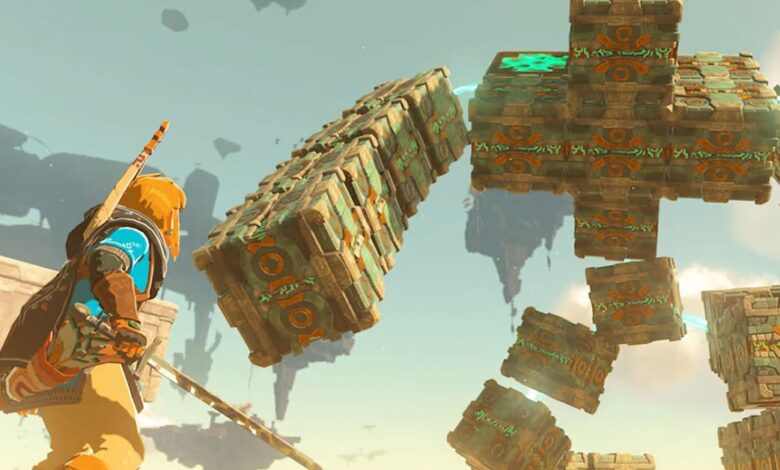How the team behind Zelda made physics feel like magic

The Legend of Zelda: Tears of the Kingdom is a phenomenal game, praised for being able to improve and iterate upon Breath of the Wild. In the weeks after the game’s release, it was written up with all sorts of breathless praise as people wondered how Nintendo managed to make a game that seemed to outstrip the technical capabilities of now seven-year-old Switch hardware.
To developers, the game looked like magic. But during a talk at the 2024 Game Developers Conference, Nintendo shared that it wasn’t magic but a distinct, well-executed development strategy that nevertheless seemed magical.
During the talk, Takuhiro Dohta, the technical director of Tears of the Kingdom, explained that the game had two major driving principles: “a vast and seamless Hyrule” and “multiplicative gameplay.”
The first was relatively simple. “We wanted players to see things in the distance and have players go there,” Dohta said. This philosophy was carried over from Breath of the Wild, with the new challenge of seamlessly connecting the sky, surface, and underground. We can see how that integration worked in Tears of the Kingdom in Link’s free falling pose as he descends from sky to surface and again between surface and the underground. The action ties the three different worlds of Hyrule together.
:format(webp)/cdn.vox-cdn.com/uploads/chorus_asset/file/25362335/Switch_SequelZeldaBOTW_screen_01__1_.png)
Image: Nintendo
However, Dohta cautioned that creating a large, interconnected world doesn’t mean it will inherently be fun. The fun, he explained, comes from the second principle: multiplicative gameplay.
Dohta defined multiplicative gameplay as a system by which players combine actions and objects to create their own ways to play. The developers, Dohta explained, did not want to create fun through discretely designed moment-to-moment gameplay events, rather they wanted to create a system that “lets fun happen.”
The seeds of this “let fun happen” system first sprouted in Breath of the Wild and its Octo Balloons, a monster part that Link could attach to heavy objects to make them float in the air. For Tears of the Kingdom, the developers expanded on that idea to encompass sticking together all kinds of objects resulting in the Fuse and Ultrahand abilities — powers that let Link combine objects to build weapons, items, and structures.
But for multiplicative gameplay to truly work, every interactive object in Hyrule had to behave in specific and predictable ways. This required what Takahiro Takayama, Tears of the Kingdom’s physics programmer, described as “an entirely physics-driven world.”
One of the first problems that arose was the clash between what Takayama called physics-driven objects and rigid body objects. Rigid body objects are objects whose every property — mass, velocity, weight, and more — is specifically designed regardless of its appearance. Early in Tears of the Kingdom’s development, the various gear mechanisms in Hyrule were rigid body objects. Meanwhile, a physics-based object’s properties are governed by physics; the big metal boxes that litter the Sky Islands above Hyrule are an example.
Takayama explained that though rigid body objects were easy to make, they created all kinds of problems when thrown into the mix with physics-driven objects. Like matter and antimatter, when a physics-driven object interacted with a rigid body object, the world broke. One example involved rigid body gears clipping through a metal box that had been inserted between them. The solution to this problem was simple. “Everything, without exception being physics-driven, is necessary to make multiplicative gameplay a reality,” Takayama said.
With everything being physics-driven, every interactive object in Hyrule would behave the way a player expects it to — the metal box now stops the gears from turning.
Hyrule then becomes “a world where players can express their creativity without [fear of] breakdown,” Takayama said. “A world where anything can happen depending on the player’s imagination.”
Takayama said making everything physics driven eliminated the need for what he called “dedicated implementation.” This would involve creating a program for every function and interaction. Without a physics-driven system, Link’s every action would require its own bespoke program to make it work. If developers want Link to drive some kind of vehicle, they would need to make a dedicated program that governed vehicles.
Though making every object in Hyrule physics driven was technically challenging, it alleviated the necessity of creating so many dedicated programs down the line in the development cycle.
“Instead of creating a vehicle program,” Takayama explained, “we created a system in which vehicles could be made.”
:format(webp)/cdn.vox-cdn.com/uploads/chorus_asset/file/25362336/Switch_TLOZ_TOTK_Screen_25.jpg)
Image: Nintendo
The distinction may seem subtle, but in that subtlety is where all the “magic” of Tears of the Kingdom lays. When developers freaked out over Tears of the Kingdom’s bridge physics, wondering how they programmed bridges to behave properly without glitching, the truth was that they made systems governing every individual component of a bridge: its slats, links, and even the various forces like wheels that would interact with it. Even the game’s music made use of this modular approach. Junya Osada, Tears of the Kingdom’s sound designer, explained that the game’s wagon sounds didn’t come from his team going out and recording a horse-drawn wagon.
“There is no wagon sound but the sound of wheels, chains, and creaking joints,” Osada said.
These systems facilitated the kinds of emergent gameplay that made Tears of the Kingdom such a special game. Players were able to use them in ways the developers themselves never thought of.
One example of these systems at work is the humble portable pot Zonai device. In Breath of the Wild, cooking was done in dedicated locations, but with the portable pot Link could now cook anywhere. Because everything, including cooking ingredients, was physics driven, developers were faced with a problem: should Link decide to cook on the side of a mountain, all his ingredients would slide out of the pot.
With dedicated implementation, the pot would simply cook no matter where it was placed and nothing else. However, the multiplicative gameplay philosophy ensured that no matter where a pot was placed, the cooking surface would orient horizontally so your soup won’t spill. That gave the pot a greater purpose beyond cooking, allowing it to be used as a ball-and-socket joint leading to all kinds of wacky creations.
Nintendo’s Tears of the Kingdom panel explained that the success of the game was guided by the idea that players should make their own fun undergirded by a robust physics system that applied to every single object in the game. But the talk featured another, unspoken reason that contributed to Tears of the Kingdom being on every 2023 Game of the Year shortlist: Nintendo keeps its talent.
In an industry where the average career length is measured in the single digits, every single speaker worked for Nintendo for at least 10 years. That kind of retention is a huge factor for Nintendo’s continued success. Institutional knowledge gets preserved and teams are able to work together more easily with limited disruption from turnover. Though Nintendo is by no means a perfect company, it seemingly understands that the best way to get good games is to employ and retain good people.
“Working together with game designers and artists who understood the vision,” Dohta said, “was essential in bringing this vast world to life.”


